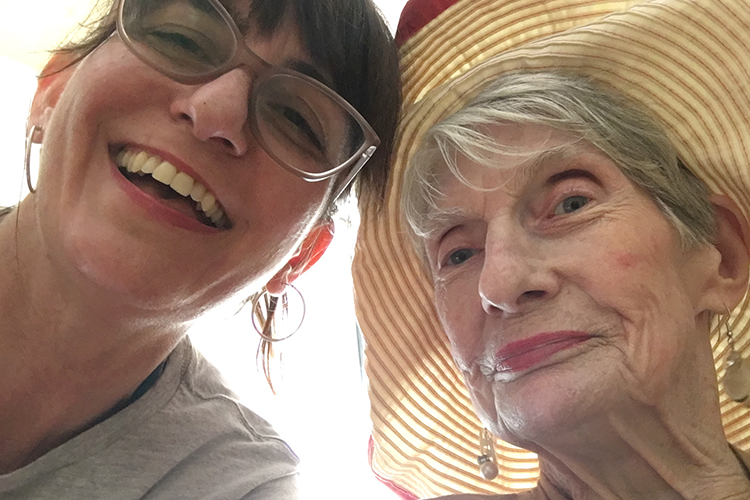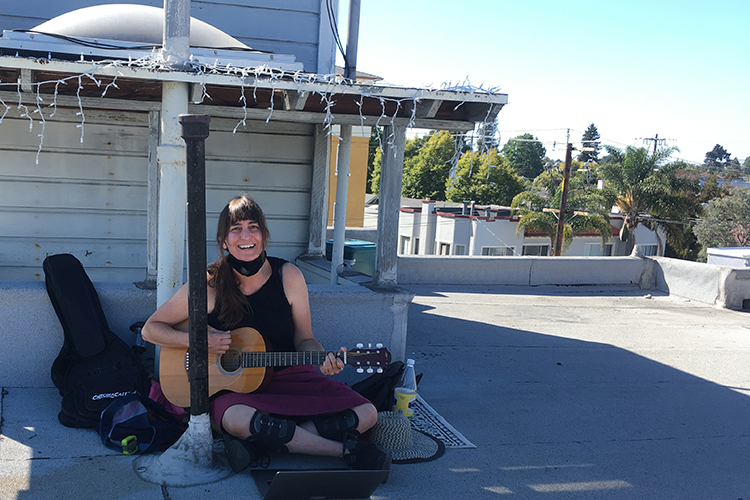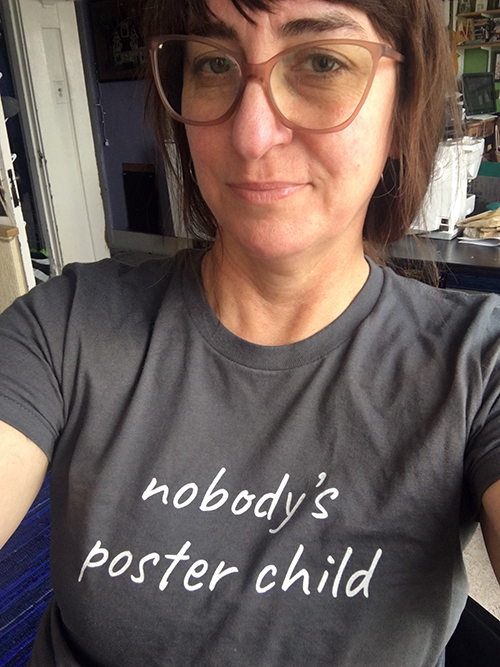
Diana Stasko (left) is the social media marketing manager at UC Berkeley’s School of Public Health and the chair of the Staff Alliance for Disability Access. Her mother, Shirley (right), has been a strong role model for Stasko throughout her life. “She’s a strong, outspoken, unconventional woman,” Stasko said. (Photo courtesy of Diana Stasko)
This I’m a Berkeleyan was written as a first-person narrative from an interview with Diana Stasko, social media marketing manager at the School of Public Health and chair of the Staff Alliance for Disability Access.
My mom was a very strong role model for me. She’s a strong, outspoken, unconventional woman who was in a wheelchair from about the age of 65 and on. Prior to that, she used a walker, and prior to that, she used a cane. So, for almost all of my growing up, my mom was “disabled.”
If a driver pulled in front of her, she’d hit their car with her cane. She wasn’t afraid of speaking out for what she wanted and what she needed. She’d had a whole career as an interior designer. But there were no job accommodations in the late ‘80s and early ‘90s, so when she was no longer able to walk, she went on disability and retired.

Stasko celebrates her mom’s 45th birthday. Her mom, who has a degenerative neuromuscular disease, went from using a cane to a walker to a wheelchair over about 15 years. She had to retire early from her career as an interior designer because she didn’t have access to disability accommodations. (Photo courtesy of Diana Stasko)
Like my mom, I have Charcot-Marie-Tooth. It’s a neuromuscular disease, and it’s degenerative. In my family, there were many people with disabilities, whether it was that or something else. I just watched them do whatever they had to do from their wheelchairs. My grandmother cooked and coordinated huge family dinners for 40 people from her chair. My mom would go everywhere and anywhere in her chair — she rode the bus all over town.
Since I was in my early 20s, I have known exactly what I was facing. The emotional impact of that sneaks up on me.
I watched the progression of my mom’s disease. I was there — I helped her. I was her only child at home, so I was the one, really, to observe the entire process with her, which has been extremely poignant to watch, and it has very much influenced my choices and my strategy for my future and how I’m going to take care of myself when I’m old.
I have to be extremely together financially. I’m quite strategic about the work that I take. I’m going to have to live in a single-story building with ramps. I am fully anticipating that I will be in a wheelchair at some point. It might not happen, but that’s just what I’m planning for.

As chair of the Staff Alliance for Disability Access (SADA), Stasko is thinking strategically about how to connect with other people with disabilities — students, faculty and staff — across campus to grow to be even more impactful. “I’ve found that I’m all about community,” she said. (Photo courtesy of Diana Stasko)
Within the space of a few years, I went from being able to walk without support to wearing leg braces. It was an eye opener for me. I had to confront a lot of my own beliefs around disability. I would tell my mom, “If you would just take this vitamin. If you would just do this exercise.” And, lo and behold, I had no idea. And once people figured out what I had going on, they would say those things to me. So, karma came around to me. I had to be educated about disability.
My grandmother’s generation learned that you don’t talk about having a wheelchair or you don’t talk about that person — what’s “wrong” with them. And I’ve found that a lot of people still feel stigmatized by disabilities, particularly people with “invisible” disabilities, like attention deficit or chronic pain, things where you could look at someone and not know. But they’ve got things that are impacting their work life, and they may not feel comfortable being out about their disability, even today.
There’s a prevalent belief that if a person has a disability, their body or mind is broken and needs to be fixed. But a lot of disability activists will tell you: ‘The issue is not that there’s something wrong with me because there is no normal. The issue is that I can’t access something I need.’
There’s a prevalent belief that if a person has a disability, their body or mind is broken and needs to be fixed. But a lot of disability activists will tell you: “The issue is not that there’s something wrong with me because there is no normal. The issue is that I can’t access something that I need — because the equipment doesn’t exist; the willingness on the part of employers, urban planners, web administrators doesn’t exist; the policy doesn’t exist; the technology doesn’t exist.” Some of that we can control, but some of it we can’t.
As chair of the Staff Alliance for Disability Access (SADA), I’m thinking strategically about how we can connect with other people with disabilities — students, faculty and staff — across campus to grow to be even more impactful. In this position, I’ve found that I’m all about community. It’s important that we’re creating an environment where people feel welcome and where they know how to access whatever tools they need to apply for a job and to do their job.
I would love there to be a campuswide coalition of people working to make Berkeley more accessible. At SADA, we’ve been reaching out to folks in the campus community of accessibility and disability, like anthropology professor Karen Nakamura, who started and leads the Berkeley Disability Lab; Ann Wai-Yee Kwong, the coordinator of the new Disability Cultural Center, which will open later this month; and to student advocates, asking them to speak at our general meetings.
I also created a newsletter about events we’re putting on and resources that folks might not know about. For example, the California Department of Rehabilitation has this whole training and employment program for folks with disabilities that’s paid for by the state. There’s also a new campuswide, student-led faculty and staff training program called Disability Beyond Compliance. Getting people resourced and building community is really important to me.

“I know things can be better,” said Stasko. “That’s why I do what I do. We need to see society, government, campus putting money, time and effort into what it takes to make services, education, buildings, recreation accessible to everyone.” (Photo courtesy of Diana Stasko)
I’ve created a database of what I call “images of disability.” It’s all copyright-free photos, graphics and symbols around disability. Some disabilities are invisible, and those are harder to portray graphically. But we don’t see ourselves in marketing materials, and if we do, it’s usually for an event about accessibility and disabilities. It’s like, we want to be at this party. We want to be just another person at the party.
I know things can be better. That’s why I do what I do. We need to see society, government, campus putting money, time and effort into what it takes to make services, education, buildings, recreation accessible to everyone. Disability is sort of the last frontier of diversity, equity and inclusion — it often gets forgotten.
I would love to see Berkeley put on a celebratory weeklong event — I’m grandiose — that centers around disability and accessibility, and I would love to see that cut across all communities of practice. I’d love there to be research talks and to see alumni with disabilities present. I would love to see AXIS Dance Company, a pan-ability dance troupe, perform.
I want Berkeley to again be at the center of disability rights activism and accessibility, always asking ourselves: How can we really be forward-thinking in the area of accessibility? We’ve got a whole new generation of disability rights activists, and we’re not going to give up. I think the pandemic cracked open the door for mental health issues and accessibility issues, and no one is going to be able to close that door.
Learn more about the Staff Alliance for Disability Access and find more disability resources.